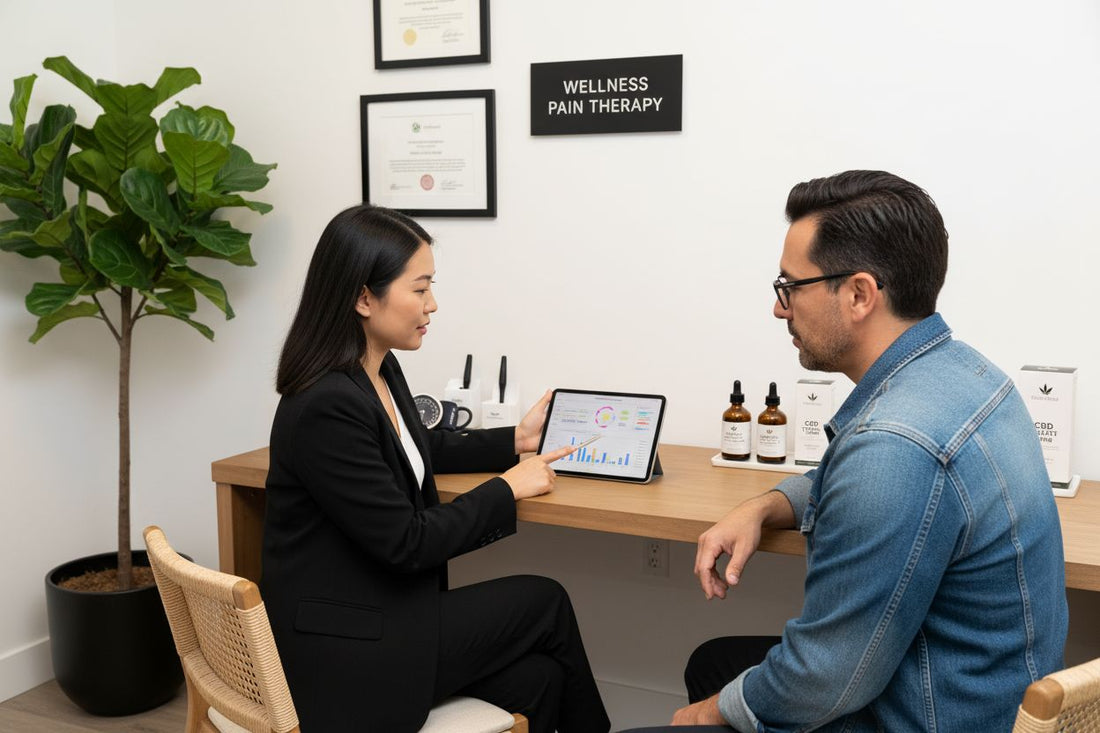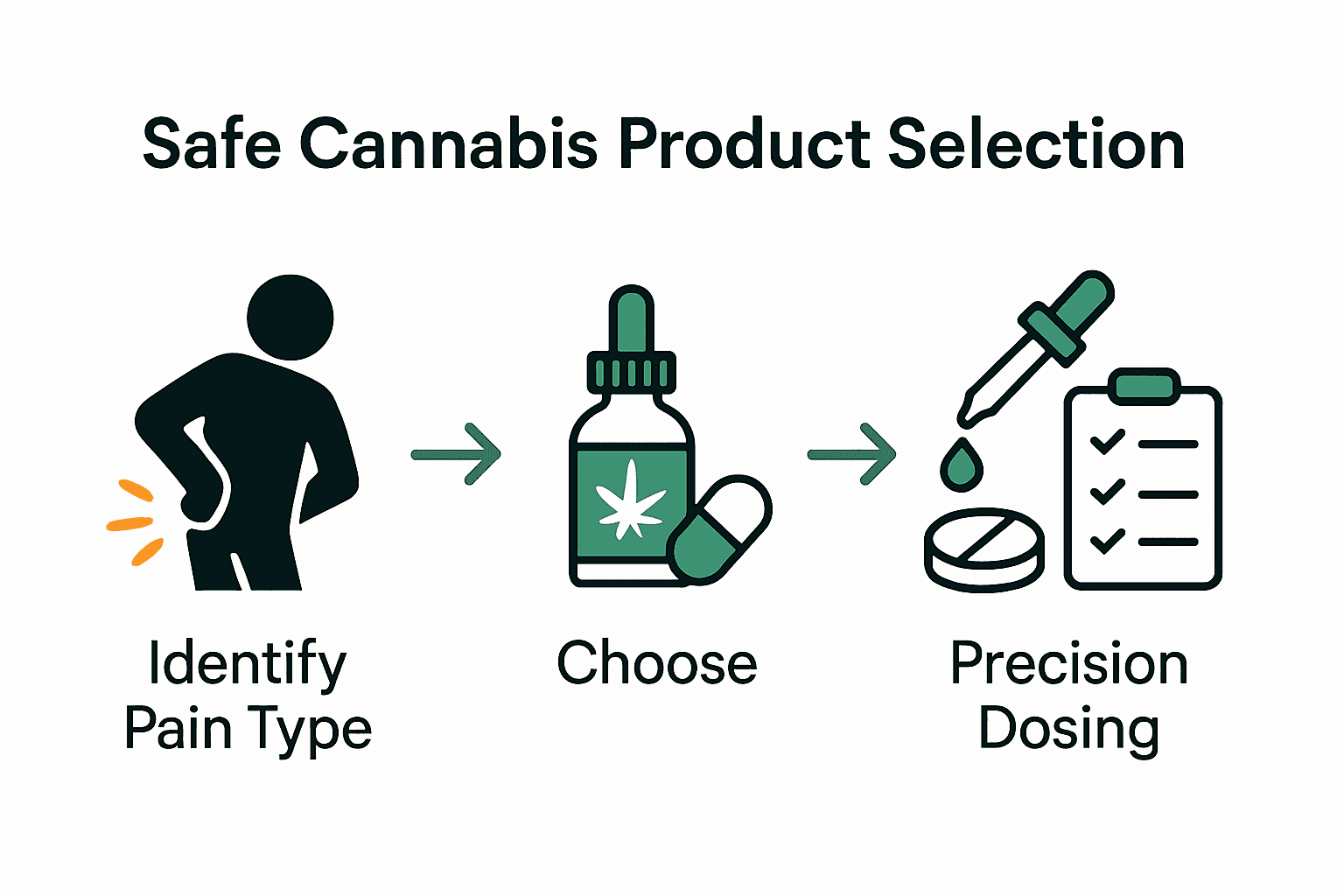How to Use Cannabis for Pain Relief Naturally
Written by Trevor

Did you know that about one in five adults worldwide experiences chronic pain? Finding the right relief method is often a challenge. With more people turning to cannabis for comfort, understanding how to use it safely matters more than ever. This guide offers clear steps to help you assess your pain, choose the best products, and fine tune your strategy for lasting relief.
Quick Summary
| Key Point | Explanation |
|---|---|
| 1. Understand Your Pain Profile | Create a detailed profile of your pain’s type and intensity to tailor your cannabis use effectively. |
| 2. Choose the Right CBD Products | Start with CBD dominant products for safer, minimal psychoactive effects in pain management. |
| 3. Follow a Systematic Dosing Strategy | Implement gradual dosing protocols to find the optimal therapeutic dosage while monitoring effects. |
| 4. Prioritize Safe Consumption Practices | Use reputable sources, measure doses accurately, and avoid smoking or vaping for health safety. |
| 5. Track Your Progress and Adjust | Keep a journal of pain levels and dosage to adjust your treatment based on responses and effectiveness. |
Table of Contents
- Step 1: Assess Your Pain And Relief Goals
- Step 2: Select Appropriate Cannabis Products
- Step 3: Determine Optimal Dosage And Form
- Step 4: Implement Safe Consumption Practices
- Step 5: Track Relief And Adjust As Needed
Step 1: Assess Your Pain and Relief Goals
Before diving into cannabis as a pain management strategy, you need a clear understanding of your specific pain experience and what relief means for you. This step helps you develop a targeted approach to using cannabis effectively.
Start by creating a detailed pain profile. What type of pain are you experiencing? Is it chronic or acute? Muscular, nerve related, inflammatory? Documenting specifics matters. According to research from the guide on benefits of CBD, different cannabinoid profiles work better for different pain types.
Next, establish realistic expectations. According to the American Family Physician systematic review, medical cannabis typically provides modest pain improvements often reducing average pain by just 1 cm on a 10 cm scale. This means cannabis can help but should not be viewed as a complete cure.
Consider tracking three key metrics:
- Pain intensity
- Sleep quality
- Daily functional capacity
Pro Tip: Use a consistent pain journal to document how different cannabis strains impact your symptoms.
Be honest about your overall health context. The Washington Post highlights potential risks including cannabis use disorder and potential mental health interactions. Consulting a healthcare provider becomes crucial in understanding how cannabis might interact with your specific medical profile.
Your goal is creating a personalized pain relief strategy tailored to your unique physiological needs. By understanding your pain profile comprehensively, you set the stage for more effective cannabis based pain management.
Step 2: Select Appropriate Cannabis Products
Choosing the right cannabis products is crucial for effective pain management. This step involves understanding your specific needs and selecting products that align with your therapeutic goals.
Start with CBD dominant products. According to the American Family Physician guidelines, low dose CBD products like sublingual drops or tablets offer a safer entry point for pain management. These products typically provide a gentler introduction to cannabis therapeutics with minimal psychoactive effects.
When exploring cannabis consumption methods, consider your comfort level and specific pain characteristics. Different delivery methods impact absorption and effectiveness differently.
Key selection criteria include:
- Pain type (inflammatory, neuropathic, muscular)
- Desired relief duration
- Personal sensitivity to cannabinoids
- Potential interactions with existing medications
Pro Tip: Health Canada recommends a ‘start low and go slow’ approach for precise dosage management.
Prioritize products that allow precise dosage control. Sublingual drops and tablets enable easier titration compared to other consumption methods. This approach helps you monitor your body’s response and adjust accordingly.
Remember that cannabis affects everyone differently. What works for one person might not work identically for another. Patience and careful observation are your best tools in finding the right product combination.

In the next step, we’ll explore how to safely experiment with your selected cannabis products to optimize pain relief.
Step 3: Determine Optimal Dosage and Form
Navigating cannabis dosage requires a thoughtful and systematic approach. This step focuses on finding your personalized optimal dosage while minimizing potential side effects.
Research from the global cannabis consensus provides three strategic dosing protocols that can guide your journey. According to the microdosing cannabis flower guide, starting with low doses and gradually increasing allows for careful monitoring of your body’s response.
Experts recommend three primary dosing approaches:
Here’s a summary of key cannabis dosing strategies:
| Dosing Protocol | Starting Dose | Frequency |
|---|---|---|
| Routine Protocol | 5 mg CBD | Twice daily |
| Conservative | 5 mg CBD | Once daily |
| Rapid Protocol | 2.5-5 mg THC:CBD combo | As needed |
- Routine Protocol: Start with 5 mg CBD twice daily
- Conservative Protocol: Begin with 5 mg CBD once daily
- Rapid Protocol: Use balanced THC:CBD at 2.5 5 mg doses
Keystone principles for determining your optimal dose include:
- Start with the lowest possible effective dose
- Increase incrementally
- Monitor your body’s response carefully
- Track pain levels and potential side effects
Pro Tip: Keep a detailed journal documenting dosage changes and their impacts on your pain experience.
Consider factors like body weight, metabolism, pain intensity, and individual cannabinoid sensitivity. Each person responds differently to cannabis products. What works for one individual might require adjustment for another.
Remember that finding the right dosage is a process of patient experimentation. Be prepared to adjust your approach based on your unique physiological response.
In the next step, we will explore how to safely implement and monitor your selected cannabis pain management strategy.
Step 4: Implement Safe Consumption Practices
Safe cannabis consumption requires thoughtful strategies and careful attention to potential risks. This step focuses on protecting your health while maximizing therapeutic benefits.
According to the guide on buying cannabis online safely, selecting reputable sources is your first line of defense in ensuring product quality and safety.
Edibles present unique consumption challenges. Research from EatingWell highlights critical considerations:
- Delayed onset can last up to 2 hours
- Risk of accidental overconsumption
- Potential for unexpected anxiety or digestive issues
Key safety practices include:
- Start with minimal doses
- Wait sufficient time between consumption
- Store products securely away from children and pets
Pro Tip: Use precise measuring tools to control exact dosage and prevent accidental overconsumption.
The Washington Post recommends avoiding smoking or vaping due to potential health risks. Instead, consider low dosage edibles or alternative consumption methods that minimize respiratory exposure.
Always consult healthcare providers before integrating cannabis into your pain management strategy. Individual health conditions can significantly impact how your body processes cannabinoids.
Remember that safe consumption is about listening to your body and making informed decisions. Patience and careful monitoring are your greatest allies in this journey.
In the next step, we will explore how to track and evaluate your cannabis pain management progress.
Step 5: Track Relief and Adjust as Needed
Tracking your cannabis pain management journey requires systematic observation and willingness to make informed adjustments. This step transforms your experience from passive treatment to active healing.
According to the determining CBD dosage guide, documenting your cannabis experience is crucial for understanding your body’s unique response.
Research reveals fascinating insights about long term medical cannabis use. A comprehensive study of chronic musculoskeletal pain patients found that over 93% of users reported high self reported efficacy. However the same study highlighted a critical observation many users were uncertain about their exact THC/CBD dosage.
Key tracking metrics to monitor include:
- Pain intensity levels
- Sleep quality
- Mobility and functional capacity
- Mood and emotional well being
- Potential side effects
Pro Tip: Use a dedicated journal or digital tracking app to record precise dosage and corresponding symptoms.
The Delphi consensus emphasizes personalized treatment. This means being flexible and willing to titrate doses based on your individual treatment goals. Some days you might need more support some days less.
Consider creating a weekly review process where you:
- Assess your overall pain management
- Review dosage effectiveness
- Discuss observations with healthcare providers
- Make incremental adjustments
Remember that cannabis treatment is not a one size fits all approach. Your body’s response will evolve and so should your strategy.

In our final step we will discuss long term considerations for sustainable cannabis pain management.
Find Natural Pain Relief You Can Trust with California Blendz
Are you struggling to identify the right cannabis products for lasting, natural pain relief? You deserve a premium experience that supports your goals for managing pain, improving sleep, and enhancing daily function. California Blendz specializes in organic, lab-tested CBD and THCa flower designed for transparency and effectiveness. Our curated THCa Prestige Vault brings you top-tier hemp flower tailored for those seeking potent relief while prioritizing health and purity.

Ready to put your pain profile and research into action? Shop our THCa Prestige Vault or explore the Founder’s Collection for trusted options. Take the next step with confidence at California Blendz and experience fast shipping, third-party lab results, and expert support. Now is the time to personalize your relief journey with products crafted for your wellness.
Frequently Asked Questions
How do I assess my pain and relief goals before using cannabis?
Before using cannabis for pain relief, create a detailed pain profile by documenting the type of pain (chronic or acute) you are experiencing. This helps you set realistic expectations and develop a tailored cannabis strategy for effective management.
What cannabis products should I start with for pain relief?
Begin with CBD-dominant products such as sublingual drops or low-dose tablets, as they offer a gentler introduction to cannabis without significant psychoactive effects. Start with low doses and observe how your body responds before adjusting.
How do I determine the right dosage for cannabis pain relief?
To find your optimal dosage, start with the lowest effective dose, such as 5 mg of CBD, and gradually increase it while monitoring your body’s response. Keep a journal documenting your dosage changes and their impacts, adjusting as needed based on your experience.
What are safe practices for consuming cannabis for pain relief?
Implement safe consumption practices by starting with minimal doses and allowing adequate time between doses, especially with edibles which can take up to 2 hours to take effect. Use precise measuring tools to ensure accurate dosing and avoid accidental overconsumption.
How can I effectively track my pain relief progress with cannabis?
Track your cannabis pain management by documenting pain intensity, sleep quality, and overall mobility in a dedicated journal or app. Review your observations weekly to assess what dosage is most effective and make necessary adjustments to your approach.
What should I do if my cannabis pain relief isn’t working as expected?
If your cannabis pain relief isn’t meeting your expectations, reassess your dosage, product choice, and consumption method. Be open to experimenting with different types of cannabis products and consult healthcare providers for tailored advice to adjust your strategy.








